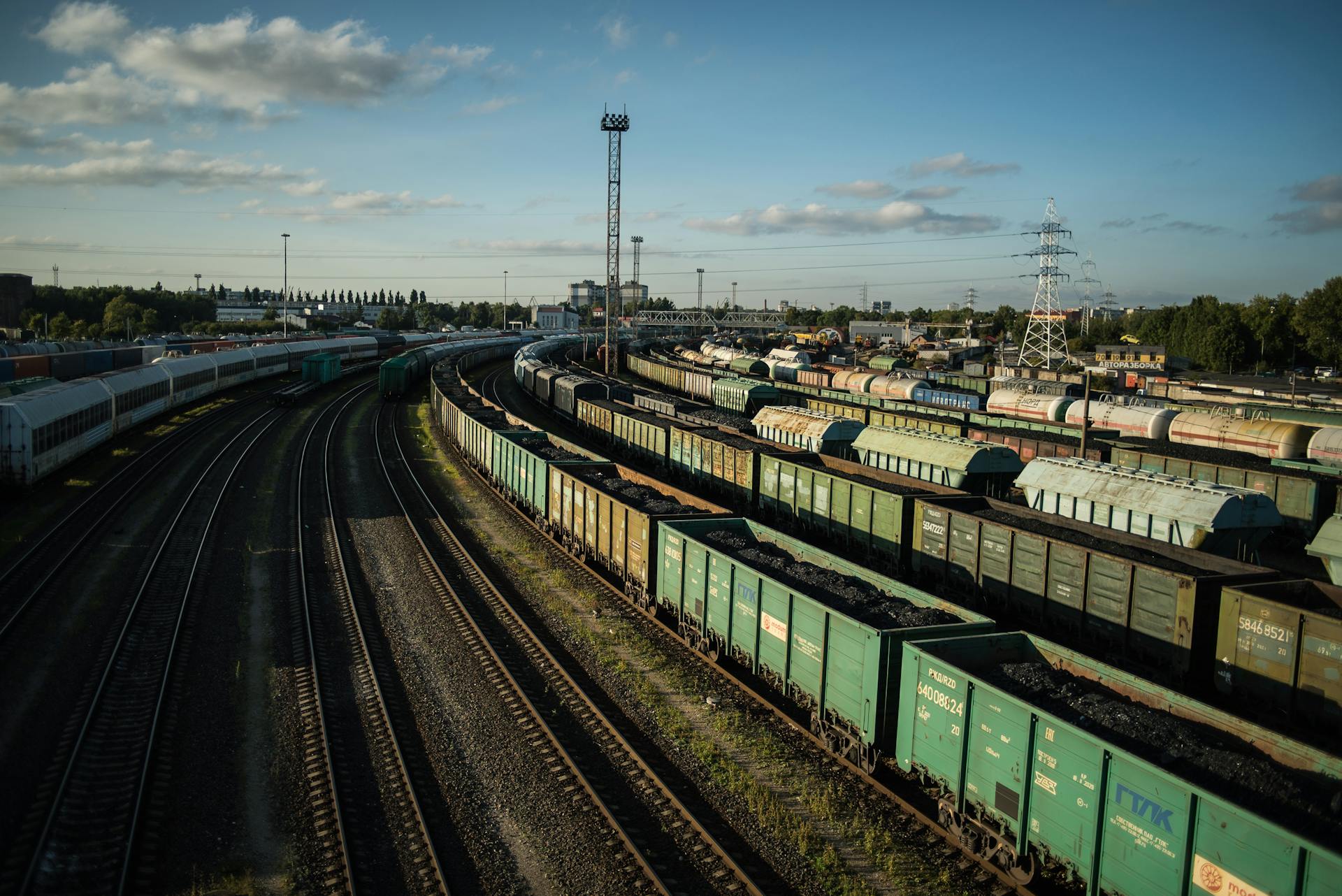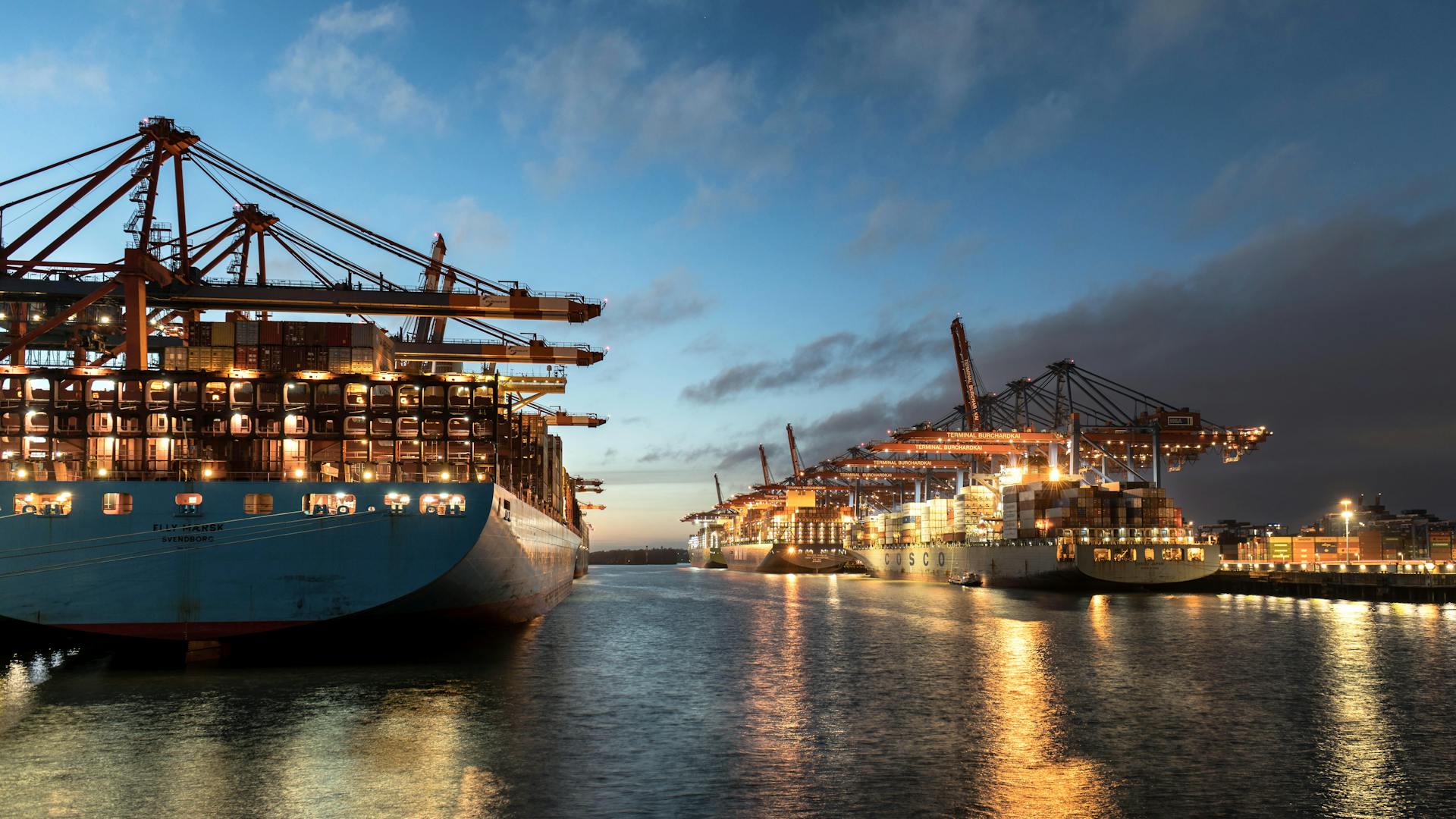
A transportation management system (TMS) is a game-changer for businesses that rely on timely and efficient delivery.
A TMS can help reduce transportation costs by up to 20% by optimizing routes and modes of transportation. This can be achieved by using advanced algorithms to analyze data and make informed decisions.
With a TMS, you can say goodbye to manual processes and hello to automated tracking and monitoring. This means you can keep a close eye on your shipments and respond quickly to any issues that may arise.
By streamlining your transportation operations, a TMS can help increase customer satisfaction and loyalty.
What is a Transportation Management System?
A Transportation Management System (TMS) is a crucial tool for any organization that relies on the efficient movement of goods throughout its supply chain network. It's essentially a system that helps you keep track of your transportation operations in real-time.
A TMS can provide real-time visibility of your entire transportation network, which is essential for making informed decisions quickly. This visibility can help you identify potential issues before they become major problems.
One of the key benefits of a TMS is its ability to coordinate fleets by balancing and allocating resources effectively. This means you can optimize your transportation operations to ensure that goods are delivered as quickly and cost-effectively as possible.
Here are some key features of a TMS:
- Real-time visibility of an entire transportation network
- Coordination of fleets by balancing and allocating resources
Benefits and Importance
A transportation management system (TMS) is a game-changer for businesses that ship goods. It offers numerous benefits, including reduced costs for both the business and the end customer.
By automating administrative tasks, such as comparing carrier rates and booking shipments, a TMS can significantly reduce administrative costs. This is especially true when compared to manual processes that require time-consuming phone calls and paperwork.
With a TMS, businesses can also lower shipping costs by automating the rating comparison process and identifying the most cost-effective options. Load optimization is another area where a TMS can trim costs by building pallets with rule-based optimization.
Real-time visibility is another critical benefit of a TMS. With real-time track and trace, businesses can track the movement of goods and assess the efficiency of their operations. This visibility also allows for route efficiency, which can be generated dynamically to identify shorter or less congested routes.
A TMS can also improve customer satisfaction by providing the visibility necessary to identify and address issues that might result in delays or customer frustration. By making it easy to track delivery progress and simplifying the billing and payment process, businesses can improve the end customer experience.
Some of the key benefits of a TMS include:
- Reduced costs for the business and the end customer
- Simplification of supply chain processes across geographies, modes, and carriers
- Automation of business operations for faster and more accurate billing and documentation
- Improvement in visibility and security, especially in transit
- Time savings—fewer manual steps result in fewer delays and faster delivery times
- Better import and export compliance minimizing penalties and shipment delays
- New business insights as better reporting leads to faster action and process improvement
- Improvements in customer service and customer satisfaction with real-time updates and fewer shipment delays
- The ability to scale the business by meeting and exceeding customer demands for fast, on-time shipments
By leveraging a TMS, businesses can optimize the flow of goods within their supply chain network, leading to increased profitability and improved customer satisfaction.
Functionalities
A transportation management system (TMS) is a software that helps businesses manage their transportation operations more efficiently. It can dramatically reduce complexity and improve efficiency by streamlining various processes.
A TMS manages four key processes of transportation management: planning and decision making, transportation execution, transport follow-up, and measurement. These processes are crucial for ensuring that goods are transported on time and in the right condition.
Planning and decision making involves defining the most efficient transport schemes, taking into account various factors such as transport cost, lead-time, and quality. This process is critical in determining the best mode of shipment, whether it's air, ocean, truck, or rail freight.
Transportation execution involves executing the transportation plan, including carrier rate acceptance, carrier dispatching, and EDI (Electronic Data Interchange). This process ensures that the transportation plan is carried out smoothly and efficiently.
Transport follow-up involves tracking the physical or administrative operations related to transportation, such as tracing transport events, editing reception and customs clearance documents, and sending transport alerts. This process helps to identify any issues that may arise during transportation.
Measurement involves tracking key performance indicators (KPIs) to measure the effectiveness of the TMS. This includes tracking metrics such as transport costs, lead-time, and quality.
Here are some of the various functions of a TMS:
- Planning and optimizing terrestrial transport rounds
- Inbound and outbound transportation mode and transportation provider selection
- Management of motor carrier, rail, air, and maritime transport
- Real-time transportation tracking
- Service quality control in the form of KPIs
- Vehicle Load and Route optimization
- Transport costs and scheme simulation
- Shipment batching of orders
- Freight Negotiation
- Cost control, KPI reporting and statistics
- Freight Audit
Plan, Execute, Optimize for Timely Delivery

A transportation management system (TMS) can help any business plan, execute, and optimize the physical movement of goods.
By using a TMS, you can select the optimal mode of shipment and the best carrier, based on cost, efficiency, and distance, including optimizing multi-leg carrier routes.
A strong TMS can provide visibility into every stage of the supply chain, giving you real-time information on trade and tariffs, and potential delays due to customs and other trade regulations.
The execution features of a TMS vary, but can include matching loads and communicating with carriers, documenting and tracking shipments, and assisting with freight billing and settlement.
With a TMS, you can configure scenarios to see probable outcomes from pending changes and demand spikes, automating shipment variance detection and resolution to reduce dead space in trailers.
TMS route optimization calculates the ideal path for carriers and shippers to take to reach a destination, reducing miles traveled and lowering energy consumption and emissions.
A TMS can help you find rates, plan routes, and select carriers, using complex algorithms to optimize each shipment and save time and money throughout the shipping process.
TMS optimization capacities include measuring and tracking performance with reports, dashboards, analytics, and transportation intelligence, helping you make data-driven decisions.
Optimization and Analytics
A TMS can help any business plan, execute, and optimize the physical movement of goods. This includes the ability to measure and track performance with reports, dashboards, analytics, and transportation intelligence.
Route optimization is a crucial component of a TMS, calculating the ideal path for carriers and shippers to take to reach a destination. This reduces miles traveled, lowering energy consumption and emissions.
TMS solution capabilities can reduce miles on routes traveled by unveiling opportunities for the most optimal stops and fuel-up stations. This results in optimized carrier loads that maximize capacity efficiently.
Analytics and reporting play a crucial role in how modern TMS solutions operate, providing actionable insights to highlight areas or holes in the transportation network that need to be more efficient. By leveraging data, users can maximize productivity with performance metrics, cost analysis, and carrier scorecards.
Real-time shipment tracking provides instant notifications and details of happenings of whichever status the shipment is currently in. This includes before, during, and after the transportation of goods.
Users of modern TMS gain better visibility by tracking all shipments moving within the transportation network. This includes real-time insights into data on traffic, capacity, and market rates.
Cloud and Technology
Cloud and technology are transforming the way we manage transportation. A cloud-based transportation management system delivers many business benefits, including improved economies of scale and lower total cost of ownership.
With a cloud-based TMS, you can enjoy faster deployments and fewer hours needed for training and installation. Automatic updates with the latest features also ensure you're always up-to-date.
New technologies are also making a huge impact on the industry. Artificial intelligence brings innovations such as handling routine tasks and delivering significant time and cost benefits.
Machine learning can quickly make accurate predictions based on huge data sets, helping businesses manage trade-offs between cost savings and on-time delivery. For example, machine learning can help calculate the impact of more expensive single-stop deliveries versus cost-effective multi-stop deliveries.
Internet of Things (IoT) sensors collect invaluable information that can be used to identify equipment that needs to be serviced and maintained. This makes the process more efficient as more equipment is equipped with sensors.
Advanced analytics helps optimize routes and shipping modes, improve delivery times, increase fuel efficiency and profitability, and adapt to changes in transportation demand. As increasing volumes of data are generated, the role of analytics becomes even more essential.
A cloud-based TMS enables businesses of various sizes to run transportation management software applications from remote locations, increasing agility and scalability.
Supply Chain
A transportation management system is a crucial component of a supply chain, and it's not just about moving goods from point A to point B. In fact, a typical SCM system includes procurement, product lifecycle management, supply chain planning, order management, manufacturing, inventory, and warehouse management.
These components work together to ensure that the right products are delivered to the right place at the right time. Transportation management is just one part of the puzzle, but it's a critical one.
Cold chain management is another important aspect of transportation management systems. It's used to maintain different temperatures at various checkpoints along the supply chain, which is especially important for perishable or temperature-sensitive materials and products.
With cold chain management, the temperature can be monitored in real-time, providing valuable information to businesses and regulators. This helps ensure that goods are kept at the right temperature throughout the supply chain.
Market
The transportation management system market is growing rapidly. Gartner predicts it will expand by 60% from $1.3 billion in 2019 to $2.1 billion in 2024. This significant growth indicates increasing demand for efficient transportation solutions.
Challenges and Solutions
Transportation management systems can be a challenge to navigate, especially when using legacy or siloed systems.
The challenges that arise from transportation management when addressed via legacy or siloed transportation management systems include:
Challenges of TMS can be overwhelming, but understanding them is the first step to solving them.
Legacy or siloed transportation management systems can make it difficult to manage transportation efficiently.
Transportation management systems that are not integrated can lead to errors and inefficiencies in the transportation process.
Challenges of TMS can be addressed by implementing a modern and integrated transportation management system.
This can help reduce errors and improve the overall efficiency of the transportation process.
Implementation and Integration
Implementing a Transportation Management System (TMS) can be a significant undertaking, but it's essential to understand the process to ensure a smooth transition.
Implementation can take anywhere from a few days to over six months, depending on the size of your business and the complexity of your supply chain.
A good TMS provider will work closely with your team to get your team up and running, making the process as efficient as possible.
For smaller shippers, implementation typically takes 1-2 months, while larger, more complex networks may require 3-6 months to fully integrate.
Implementing a System
Implementing a Transportation Management System (TMS) can be a significant undertaking, taking anywhere from a few months to over six months, depending on the business size and project scale.
The process typically involves several stages, including a kickoff meeting, design, build, preparation, testing, deployment, and ongoing support from the TMS provider.
A well-planned implementation can make all the difference in ensuring a smooth transition to a new system.
The right TMS for your business will depend on the needs and complexity of your individual transportation network.
Choosing the right TMS requires careful consideration of your business's specific requirements.
A simple, six-step process can help you choose the right TMS for your business.
Integration with other systems, such as warehouse management and labor management, can provide significant technological benefits that optimize the flow of goods in and out of the entire supply chain process.
Unified systems on a cloud-native platform can share real-time data and receive upgrades automatically without disrupting day-to-day workflows.
This level of integration can also develop holistic planning and allow for continuous optimization to fit changing business needs.
Integration/Unification
An integrated TMS, unified with other supply chain software solutions on a singular platform, provides a link between distribution and transportation for optimal efficiency.
Larger or enterprise businesses utilize integrated TMS solutions to unify transportation, warehouse, labor, and order management to break down the barriers of inbound/outbound workflows.
Depending on various factors such as supply chain size, industry, and complexity, each type of TMS provides its own set of beneficial outcomes to improve transportation management.
Integrating TMS with other supply chain planning and execution systems, including warehouse management, labor management, and order management, provides significant technological benefits that optimize the flow of goods in and out of the entire supply chain process.
Unified systems can share real-time data, receive upgrades automatically without disrupting day-to-day workflows, and develop holistic planning.
Users gain total control over supply, demand, resources, and shipments with capabilities that include seamless added capacity, automatic labor adjustment to match inbound arrivals, and order changes that can be made up until the last shipment leaves the dock.
Implementing a TMS that integrates with other systems can take anywhere from 1-2 months for smaller shippers and 3-6 months for a larger, more complex networks.
A good TMS provider will work with your team closely during the implementation process and help get your team up and running.
Choosing the Right Solution for Your Business
Choosing the right solution for your business is crucial, especially when it comes to transportation management. Smaller businesses can now afford to invest in a Transportation Management System (TMS) thanks to cloud-based solutions.

You don't have to break the bank to get started, with annual freight spends of $5 million to $10 million making it more accessible for smaller companies. Cloud-based solutions have made it easier for these businesses to implement a TMS.
To choose the right TMS for your business, consider the needs and complexity of your individual transportation network. You can follow a simple six-step process to make the right choice.
A TMS can be just a platform, or it can be a full-service solution. Many providers offer outsourced transportation management services, which include dedicated support teams, KPI creation, and continuous improvement implementations.
If you're not sure where to start, consider the following options:
- Dedicated support team
- KPI creation, monitoring and reporting
- RFP management
- Continuous improvement implementations
- Network optimization
- Forecasting and cost reduction strategies
These services can help you free up resources to focus on your core business and increase flexibility and scalability.
Types and Comparison
There are different types of TMS offerings available on the market, and businesses must assess these solutions to choose the right one that fits their specific organizational and supply chain needs.

A TMS can be differentiated from a WMS, which is a digital tool that helps shippers control their inventory, organize warehouse and distribution center operations, and manage order fulfillment.
While a WMS deals with the control of freight while it's on-site at the shipper's facility, a TMS deals with the movement of freight to and from their facilities.
Both a TMS and WMS are typically integrated with a company's enterprise resource planning (ERP) system, making it easier for shippers to monitor their supply chain and make improvements to their business.
Core Types of Transportation Management Systems
There are different types of Transportation Management Systems (TMS) available on the market.
A standalone TMS solely focuses on the transportation side of supply chain logistics and is often used by shippers and carrier service providers.
Businesses must assess these different TMS solutions to choose the right one that fits specific organizational and supply chain needs.

A standalone TMS may be all that is needed for smaller businesses, but larger supply chain networks suffer from a lack of visibility, integration, shared data, and overall system unification with just a standalone TMS.
A TMS deals with the movement of freight to and from facilities, whereas a Warehouse Management System (WMS) deals with the control of freight while it's on-site at the shipper's facility.
Both a TMS and WMS are typically integrated with a company's enterprise resource planning (ERP) system, making it easier to monitor every aspect of the supply chain.
Implementation of a TMS can take anywhere from a few months to over six months, depending on business size and project scale.
WMS vs WMS Differences
TMS and WMS are two distinct systems that play a crucial role in supply chain operations. A TMS oversees logistics and transportation management, while a WMS handles distribution.
TMS and WMS systems that don't communicate with each other can create blind spots and inefficiencies. This can lead to missed opportunities for supply chain growth and optimization.
However, when both systems work together on a unified platform, they can unlock end-to-end supply chain agility, visibility, and collaboration.
The benefits of a unified platform include higher levels of utilization and more efficient operations.
Future and Trends
The future of transportation management systems is exciting and rapidly evolving. Customer expectations are rising, with many demanding on-time deliveries, two-day, and even same-day deliveries with real-time updates.
Customer expectations are no longer limited to on-time deliveries, but also include real-time updates throughout the shipment process. Ever-changing global trade regulations are forcing companies to innovate and invest in transportation management systems.
Machine learning is enabling transportation management systems to become more intelligent, providing better recommendations and more accurate predictions. This means companies can make more informed decisions and optimize their logistics and transportation processes.
Companies can choose to integrate their transportation and global trade management systems with emerging technologies to further improve visibility and offer better customer service. Some of these innovative technologies include artificial intelligence, generative AI, and conversational AI.
Generative AI is being used to automate workflows, uncover hidden insights, and accelerate innovation in transportation management. This technology is also being used to create intuitive conversational interfaces, making it easier for companies to interact with their transportation management systems.

According to Gartner, 40% of enterprise applications will have embedded conversational AI by 2024. This suggests that conversational AI is becoming increasingly important in the transportation management industry.
Technological advancements are also leading to more sustainable transportation practices. Improved modal shifts and route optimization are reducing carbon footprints and making transportation more environmentally friendly.
Frequently Asked Questions
What are the four basic functions of transportation management?
The four basic functions of transportation management are planning and decision-making, transportation execution, transport follow-up, and measurement and evaluation. These functions help optimize supply chains and improve business efficiency.
What are the three phases of TMS?
The three phases of Transportation Management System (TMS) are Planning, Execution, and Optimization, each playing a crucial role in streamlining logistics operations. By understanding these phases, businesses can improve efficiency, reduce costs, and enhance customer satisfaction.
Sources
- https://www.oracle.com/scm/logistics/transportation-management/what-is-transportation-management-system/
- https://www.sap.com/products/scm/transportation-logistics/what-is-a-tms.html
- https://en.wikipedia.org/wiki/Transportation_management_system
- https://www.manh.com/solutions/supply-chain-management-software/transportation-management/what-is-a-transportation-management-system
- https://rxo.com/resources/shipper/what-is-a-tms/
Featured Images: pexels.com


